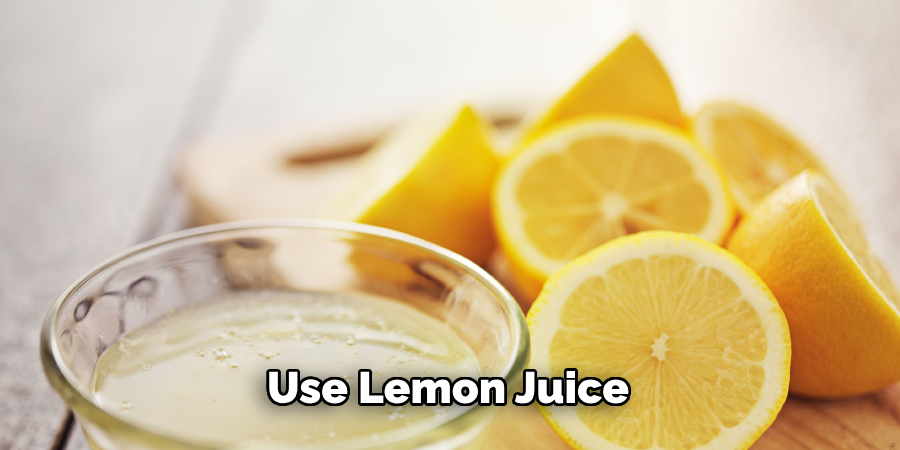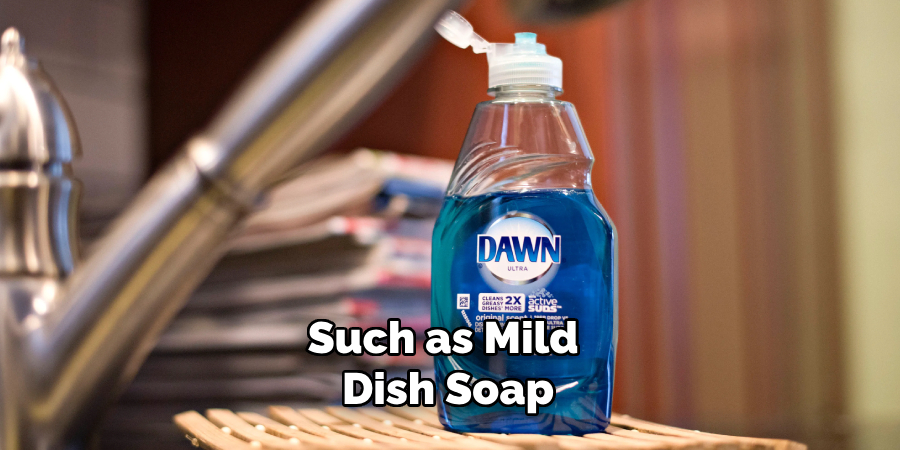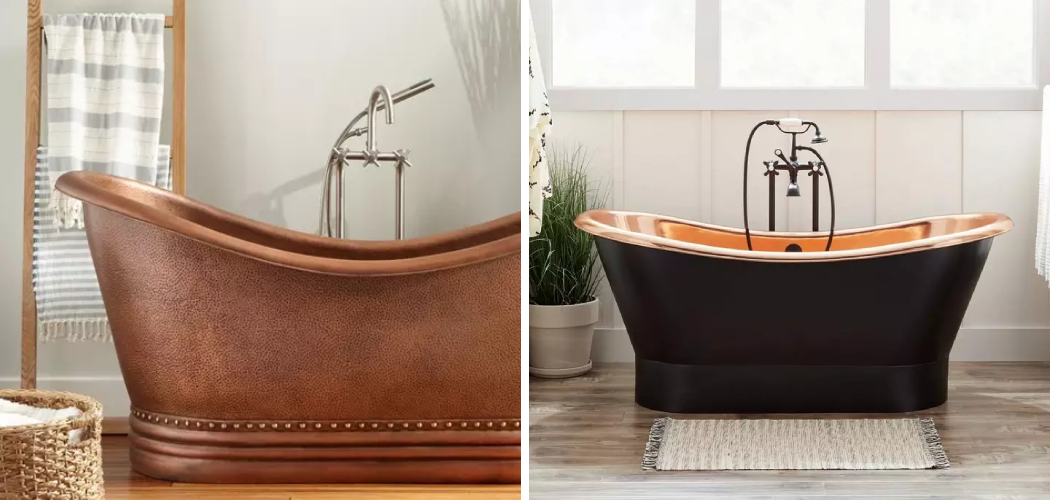Are you a proud owner of a copper bathtub? Congratulations! Copper bathtubs are not only beautiful, but they also offer many benefits such as being naturally anti-bacterial and corrosion-resistant.

However, like any other bathroom fixture, copper bathtubs require regular maintenance to keep them looking clean and shiny. In this guide, we will discuss how to clean copper bathtub.
Copper bathtubs are a luxurious addition to any bathroom, offering a unique aesthetic and exceptional durability. However, maintaining their luster and ensuring longevity requires proper care. Cleaning a copper bathtub may seem daunting, but it can be straightforward with the right techniques and materials.
This guide will explain how to effectively clean your copper bathtub, preserving its beauty and preventing damage.
What Will You Need?
Before we dive into the cleaning process, let’s gather all the necessary supplies. You will need:
- Baking soda
- White vinegar
- Lemon juice
- Soft cloth or sponge
- Non-abrasive cleaner (optional)
Once you have all the supplies, let’s start with the cleaning process.
10 Easy Steps on How to Clean Copper Bathtub
Step 1: Create a Cleaning Paste
Mix equal parts of baking soda and white vinegar in a bowl to create an effective cleaning paste. For example, you can use one cup of each ingredient for a standard-sized bathtub. This mixture creates a gentle abrasive that helps remove any built-up grime or stains on the copper surface.
Step 2: Apply the Cleaning Paste
Using a soft cloth or sponge, apply the cleaning paste to the surface of the copper bathtub. Ensure you cover all areas, especially spots with visible stains or tarnish. Use gentle, circular motions to avoid scratching the copper surface while effectively lifting dirt and grime.

Step 3: Let the Paste Sit
Allow the cleaning paste to sit on the copper surface for approximately 10-15 minutes. This resting period is crucial as it gives the mixture time to break down and loosen any stubborn stains or tarnish. Avoid letting the paste dry completely; it should remain slightly damp to ensure it can be easily wiped away without leaving residue.
Step 4: Scrub Gently
After allowing the paste to sit, gently scrub the copper surface with a soft cloth or sponge. Focus on tougher stains or tarnish areas, using a circular motion to lift the grime effectively. Remember, copper is a soft metal, so avoid using abrasive materials or excessive force as this can cause scratches and damage to the bathtub’s finish.
Step 5: Rinse Thoroughly
Once you’ve finished scrubbing, it’s time to rinse the bathtub thoroughly with warm water. Ensure all the cleaning paste is washed away, as any remaining residue can cause discoloration if left to dry. Use a separate clean cloth to help wipe down and rinse all areas, ensuring no paste remains.
Step 6: Dry the Surface
Using a dry, soft cloth, wipe down the entire surface of the copper bathtub to remove any excess water. Drying the bathtub immediately helps prevent water spots and reduces the chances of new tarnish forming. Ensure you reach all corners and edges to maintain an even finish.
Step 7: Polish with Lemon Juice
To enhance the natural shine of your copper bathtub, use lemon juice as a natural polish. Dampen a soft cloth with fresh lemon juice and gently rub it over the tub’s surface. The citric acid in the lemon juice helps to further break down any remaining grime and enhances the copper’s shine.

Step 8: Rinse Again
After applying the lemon juice, it’s crucial to rinse the bathtub thoroughly once more. Use warm water to wash away residual lemon juice, completely removing it from the surface. Lemon juice left on the copper can cause discoloration over time due to its acidic nature. Additionally, ensure that no traces of the cleaning paste or any other cleaning agents remain as it can lead to streaking or dulling of the copper’s shine.
Step 9: Dry the Bathtub
Once the second rinse is complete, dry the bathtub again using a soft, clean cloth. This step is essential to prevent water spots and streaks, which can mar the lustrous appearance of the copper. Pay particular attention to drying the crevices and edges thoroughly, as water can pool in these areas, leading to potential tarnishing or spotting later.
Step 10: Apply a Protective Coating (Optional)
Consider applying a protective coating to your copper bathtub for added protection and to maintain its shine. Use a high-quality copper wax or sealant designed specifically for copper surfaces.
Apply a thin, even layer using a soft cloth and allow it to dry as per the product instructions. This protective layer can help shield the copper from moisture and air exposure, reducing the frequency of tarnishing and keeping your bathtub looking pristine for longer.
By following these ten simple steps, you can effectively clean your copper bathtub and maintain its beauty for years to come.
5 Additional Tips and Tricks
- Use Gentle Cleaners: Always use non-abrasive cleaners, such as mild dish soap and water, to avoid scratching or damaging the copper surface.
- Rinse Thoroughly: After applying any cleaner, ensure you rinse the bathtub thoroughly with warm water to remove any residue that could tarnish the copper.
- Dry with a Soft Cloth: Use a soft microfiber cloth to dry the bathtub after cleaning, which helps to prevent water spots and unwanted mineral buildup.
- Apply a Polishing Agent: To maintain the sheen of your copper bathtub, occasionally apply a small amount of lemon juice mixed with salt as a natural polishing agent.
- Regular Maintenance: Conduct regular light cleanings instead of occasional deep cleanings to keep the copper looking vibrant and reduce the need for more intensive maintenance.

With these additional tips and tricks, you can ensure that your copper bathtub remains in top condition.
5 Things You Should Avoid
- Avoid Harsh Chemicals: Avoid cleaners that contain bleach, ammonia, or other harsh chemicals, which can corrode the copper and cause permanent damage.
- Don’t Use Abrasive Pads: Never use steel wool, scouring pads, or other abrasive materials, as these can scratch the copper surface and diminish its natural beauty.
- Skip the Acidic Cleaners: Avoid using highly acidic substances like vinegar or conventional bathroom cleaners, as they can strip away the protective patina and stain the copper.
- Prevent Prolonged Water Exposure: Do not leave water sitting in the bathtub for extended periods, as this can lead to water spots and mineral residue that is difficult to remove.
- Forget the Stiff Brushes: Hard-bristled brushes can scratch and damage the copper surface. Instead, utilize soft-bristled brushes or cloths for cleaning.
By steering clear of these pitfalls, you can protect your copper bathtub from unnecessary damage and preserve its lustrous finish.
Are Copper Bathtubs Hard to Maintain?
While copper bathtubs require specialized care and attention, they are not necessarily difficult to maintain. With proper cleaning techniques and regular maintenance, you can keep your copper bathtub looking beautiful for years to come.
One key factor in maintaining a copper bathtub is avoiding harsh chemicals and abrasive materials. As mentioned before, these can cause irreparable damage to the tub’s surface. Instead, opt for gentle cleaners and non-abrasive tools when cleaning.
Regular maintenance is also important to keep your copper bathtub in top condition. This includes conducting light cleanings regularly instead of waiting for deep cleanings occasionally. This will help prevent the buildup of grime and mineral deposits, making it easier to maintain the bathtub’s shine.
Caring for a copper bathtub is generally similar to caring for any other type of tub. The main difference lies in the materials and cleaners used.
Is Bathing in a Copper Tub Healthy?
Bathing in a copper tub has been touted as having some potential health benefits. Copper is known to have antimicrobial properties, which means it can help kill bacteria and other harmful microorganisms on contact. This makes copper bathtubs popular for people looking for a more natural and chemical-free way to clean themselves.
In addition, copper bathtubs’ warmth can also provide therapeutic benefits. The material retains heat well, creating a warm, relaxing bathing experience that can soothe sore muscles and joints.
However, it’s important to note that these potential health benefits are not scientifically proven. While some anecdotal evidence may support the use of copper bathtubs for health purposes, it should not be relied upon as a primary form of treatment. It’s always best to consult a healthcare professional for specific health concerns.

Conclusion
Maintaining the beauty and integrity of your copper bathtub is manageable if you approach it with the right knowledge and care.
By adhering to some simple yet effective cleaning techniques, you can ensure that your bathtub remains a stunning centerpiece in your bathroom.
Always use gentle, non-abrasive cleaners and avoid harsh chemicals that can damage the copper.
Regular maintenance, including thorough rinsing and drying after each use, will help prevent water spots and mineral buildup. Additionally, occasional light polishing with natural agents like lemon juice and salt can keep your tub’s sheen glowing.
By following these tips on how to clean copper bathtub, your copper bathtub will continue to provide both aesthetic pleasure and potentially therapeutic benefits for years to come.

